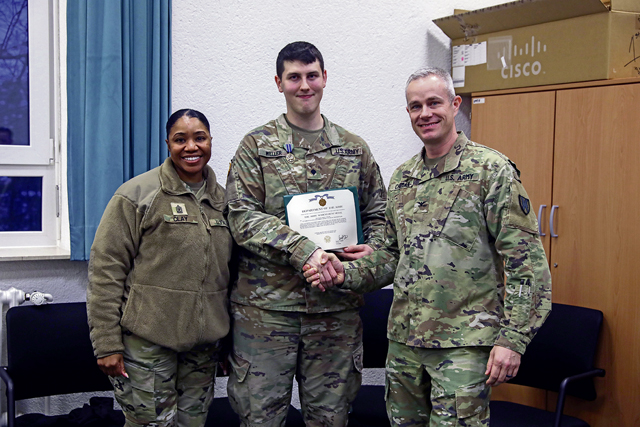
The 1st Human Resources Sustainment Center, 21st Theater Sustainment Command, held a validation exercise, Valiant Knight 23 on Panzer Kaserne, Jan. 26. The training was split into two situational training exercise lanes: Non-combatant Evacuation Operations and Deployed Theater Accountability System.
The training validated the mission essential task assessments and served to identify improvements needed in training areas in preparation for upcoming missions, such as Silver Falcon and Defender. Valiant Knight gave the Soldiers the opportunity to showcase their skills and knowledge.
“We’re working at such a strategic level that others don’t really get to see what it is that they do,” said Maj. Quincy Banis, personnel accountability and systems division chief, 21st TSC “This allowed us to recognize the Soldiers for all their accomplishments and the knowledge and experience they bring to the table.”
The exercise began by splitting the Soldiers into two teams named, Alpha and Bravo. The teams consisted of information technology and human resources specialists. The first task tested their ability to set up a tactical LAN [local area network].
“So, we began by setting up GATR [Ground Antenna Transmit and Receive] communications. It’s a small ball antenna that shoots out to the satellite,” said Sgt. Gerardo Mota, information technology specialist, 21st TSC.
Once communications were set, the teams began non-combatant evacuation operations. The Soldiers were tasked with registering and creating a manifest of the evacuees, families, and their pets.
“I’ve learned to expect the unexpected. No matter how hard you try to prepare yourself, anything can happen,” said Spc. Louisa Geneus, human resources specialist, 21st TSC.
NEO operations present a mirage of challenges that Soldiers must overcome to accomplish the mission, such as the recent events of Operation Allies Welcome and Operation Allies Refuge, with the evacuation of personnel from Afghanistan.
“I think the biggest thing with NEO is, it’s always going to happen in the face of catastrophe or some type of crisis incident,” said Banis. “Something that is causing such a huge catastrophe that [evacuees] have to physically leave their home, and just recognizing that, that is why the Department of Defense has put such a huge level of importance on them.”
The second lane focused on the DTAS system. The teams were responsible for manifesting and managing inbound theater personnel utilizing Tactical Personnel System and uploading the manifest into Aerial Port of Debarkation.
“I will say for my team, we could have communicated a little bit better,” said Geneus. “But so far, our outcome is not as bad as I thought it would be. So, I’ll say we did pretty good based off my expectations.”
Training exercises like this provide the opportunity for Soldiers to refine their skills and make corrections.
“I think it was a great experience,” said Mota. “There were a lot of challenges on both ends, the 25 bravo side and the 42 alpha side and I feel like we all learned something collectively.”
Banis mentioned, while there is always room for improvements, the training overall went very well and met the intent of the tasks they set out to accomplish.
“We definitely have some things that we want to focus more on, such as the ability to better integrate our communications piece of what we do,” said Banis. “We kind of forget what the 25 bravos bring to the fight and how much we rely on them, and this exercise kind of imparts how important it is for them to understand the 25 bravos capabilities.”
The training concluded with validation results, an after-action report, and an award ceremony.


